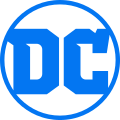
Poison Ivy is a character appearing in American comic books published by DC Comics, commonly in Batman stories. She was created by Robert Kanigher and Carmine Infantino, and first appeared in Batman #181.

The Justice League is a team of superheroes appearing in American comic books published by DC Comics. The team first appeared in The Brave and the Bold #28. The team was conceived by writer Gardner Fox as a revival of the Justice Society of America, a similar team from DC Comics from the 1940s which had been pulled out of print due to a decline in sales.

The DC Universe (DCU) is the fictional shared universe where most stories in American comic book titles published by DC Comics take place. Superheroes such as Superman, Batman, Wonder Woman, Robin, Martian Manhunter, The Flash, Green Lantern, Aquaman, Green Arrow, and Captain Marvel are from this universe, as well as teams such as the Justice League, Teen Titans and the Suicide Squad. It also contains well-known supervillains such as the Joker, Lex Luthor, the Cheetah, Catwoman, Harley Quinn, Poison Ivy, Deathstroke, Deadshot, Black Adam, Professor Zoom, Black Manta, the Penguin, the Riddler, the Scarecrow, Two-Face, Ra’s al Ghul, Sinestro, Atrocitus, Brainiac, and Darkseid. In context, the term "DC Universe" usually refers to the main DC continuity.

Super Friends is an American animated television series about a team of superheroes, which ran from 1973 to 1985 on ABC as part of its Saturday-morning cartoon lineup. It was produced by Hanna-Barbera and was based on the Justice League of America and associated comic book characters published by DC Comics.
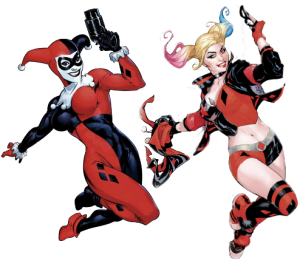
Harley Quinn is a character appearing in American comic books published by DC Comics. Quinn was created by Paul Dini and Bruce Timm as a henchwoman for the supervillain Joker in Batman: The Animated Series, and debuted in its 22nd episode, "Joker's Favor", on September 11, 1992. While intended to appear in one episode, Quinn became a recurring character within the DC Animated Universe as the Joker's sidekick and love interest, and was adapted into DC Comics' Batman comic book canon seven years later, beginning with the one-shot Batman: Harley Quinn #1. Quinn's origin story features her as a former psychiatrist at Gotham City's Arkham Asylum named Dr. Harleen Quinzel who has fallen in love with the Joker, her patient, eventually becoming his accomplice and lover. The character's alias is a play on the stock character Harlequin from the 16th-century Italian theater commedia dell'arte.

Elseworlds was the publication imprint for American comic books produced by DC Comics for stories that took place outside the DC Universe canon. Elseworlds publications are set in alternate realities that deviate from the established continuity of DC’s regular comics. The "Elseworlds" name was trademarked in 1989, the same year as the first Elseworlds publication.

Hawkgirl is the name of several superheroines appearing in American comic books published by DC Comics. The original Hawkgirl, Shiera Sanders Hall, was created by writer Gardner Fox and artist Dennis Neville, and first appeared in Flash Comics #1. Shayera Hol was created by writer Gardner Fox and artist Joe Kubert, and first appeared in The Brave and the Bold #34. Kendra Saunders was created by writer David S. Goyer and artist Stephen Sadowski, and first appeared in JSA: Secret Files and Origins #1. One of DC's earliest super-heroines, Hawkgirl has appeared in many of the company's flagship team-up titles including Justice Society of America and Justice League of America.

Katana is a superheroine appearing in American comic books published by DC Comics. First appearing in 1983, Katana is a samurai warrior whose skill with a sword allows her to fight for justice as a superheroine. Her tragic backstory includes the death of her husband, Maseo, whose soul becomes trapped in her blade, the Soultaker. Katana has been part of various DC Comics superhero teams, including the Justice League and Birds of Prey, but is most commonly associated with the Outsiders, a team of heroes hand-picked by Batman to act as his personal black ops team, handling riskier missions.
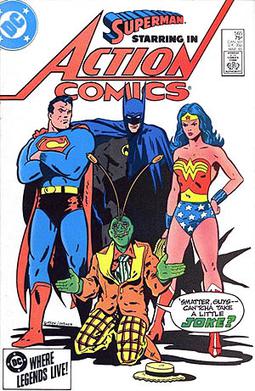
Ambush Bug is a superhero appearing in American comic books published by DC Comics. His real name is supposedly Irwin Schwab, but he has mental problems that prevent him from truly understanding reality around him, so even his true identity might be no more than a delusion on his part. His origin is disputed, although the most commonly accepted origin is that Brum-El of the planet Schwab sent his clothes from his supposedly doomed planet, hoping that his wardrobe would survive, only to have it intercepted by a giant radioactive space spider. In the resulting crash, only two articles of clothing survived: the Ambush Bug suit, which was subsequently found by Irwin Schwab; and "Argh!Yle!", an argyle sock with a Doctor Doom-like complex, complete with metal mask.

Bat-Mite is a fictional character appearing in American comic books published by DC Comics. Bat-Mite is an imp similar to the Superman villain Mister Mxyzptlk. Depicted as a small, childlike man in an ill-fitting Batman costume, Bat-Mite possesses what appear to be near-infinite magical powers, but he actually uses highly advanced technology from the fifth dimension that cannot be understood by humans' limited three-dimensional views. Unlike Mxyzptlk, Bat-Mite idolizes his superhero target and thus he has visited Batman on various occasions, often setting up strange and ridiculous events so that he could see his hero in action. Bat-Mite is more of a nuisance than a supervillain, and often departs of his own accord upon realizing that he has angered his idol.

The DC Animated Universe is a shared universe centered on a group of animated television series based on DC Comics and produced by Warner Bros. Animation. It began with Batman: The Animated Series in 1992 and ended with Justice League Unlimited in 2006. Animated feature films and shorts, comic books, video games, and other multimedia adaptations are also in the continuity.

Firefly is a supervillain appearing in American comic books published by DC Comics. Created by France Herron and Dick Sprang, he made his debut in Detective Comics #184. Initially portrayed as a criminal who utilized lighting effects to commit robberies, Firefly was later reimagined as a sociopathic pyromaniac with an obsessive compulsion to start fires following Crisis on Infinite Earths' reboot of the DC Universe in the 1980s. This darker depiction of the character has since endured as one of the superhero Batman's most recurring enemies and belongs to the collective of adversaries that make up his central rogues gallery.
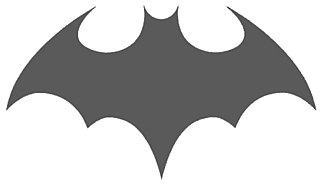
The DC Comics character Batman has been adapted into various media including film, radio, television, and video games, as well as numerous merchandising items. The Batman franchise has become one of the highest-grossing media franchises of all time.
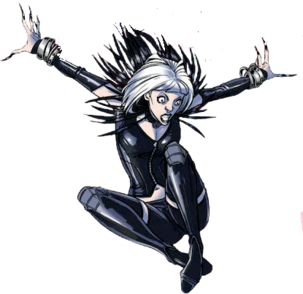
Magpie is a supervillain appearing in American comic books published by DC Comics. She was created by John Byrne, and first appeared in The Man of Steel #3.

Robin of Earth-Two is an alternate version of the fictional superhero Robin, who appears in American comic books published by DC Comics. The character was introduced after DC Comics created Earth-Two, a parallel world that was retroactively established as the home of characters which had been published in the Golden Age of comic books. This allowed creators to publish comic books taking place in current continuity while being able to disregard Golden Age stories featuring Robin, solving an incongruity, as Robin had been published as a single ongoing incarnation since inception. Unlike his main counterpart, Robin is the only alter ego of Dick Grayson, who uses the title into adulthood, rather than taking on later codenames such as Nightwing or Batman. In addition, the name "Robin" is not taken on by later characters.
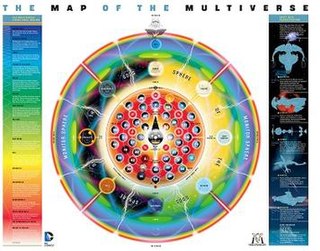
In DC Comics, the Multiverse is a "cosmic construct" composed of the many fictional universes the stories of DC take place in. The worlds in this multiverse share a space and fate in common, and its structure has changed several times in the history of DC Comics.

Limbo refers to a fictional location in books published by DC Comics. Limbo first appeared in Ambush Bug #3 and was created by Keith Giffen.


















